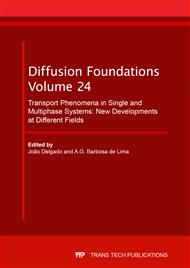[1]
W.F. Smith, J. Hashemi. Foundations of Materials Science and Engineering, fifth ed, The graw hill, Porto Alegre 2012 (In Portuguese).
Google Scholar
[2]
S. Kamila, Introduction, Classification andApplications of Smart Materials: An Overview. Am J Appl Sci10 (2013) 876-880.
Google Scholar
[3]
K. Kuribayashi, Millimeter size joint actuator using shape memory alloy. In: Micro electromechanical systems, proceedings, an investigation of micro structures, sensors, actuators,machines and robots. 1989. p.139–44.
DOI: 10.1109/memsys.1989.77978
Google Scholar
[4]
D. G. Caldwell, P.M. Taylor, Artificial muscles as robotic actuators. In: IFAC Robot controlconference (Syroc 88). Karlsruhe, Germany 1988. p.401–6.
DOI: 10.1016/b978-0-08-035742-3.50071-x
Google Scholar
[5]
Kuribayashi K. A new actuator of a joint mechanism using TiNi alloy wire. Int J Rob Res 1986;4:47–58.
Google Scholar
[6]
C. Naresh, P S C Bose, C S P Rao, Shape memory alloys: a state of art review,IOP Conf. Ser.: Mater. Sci. Eng. (2016).
DOI: 10.1088/1757-899x/149/1/012054
Google Scholar
[7]
V. Antonucci, A. Martone, Phenomenology of Shape Memory Alloys in: L. Lecce, A. Concilio (Eds),Shape Memory Alloy Engineering: For Aerospace, Structural and Biomedical Aplications, Elsevier., USA, 2014, pp.33-56.
DOI: 10.1016/b978-0-08-099920-3.00002-4
Google Scholar
[8]
A. Ölander, An electrochemical investigation of solid cadmium-gold alloys. Am Chem Soc54 (1932)3819–3833.
DOI: 10.1021/ja01349a004
Google Scholar
[9]
W.J. Buehler, J.V. Gilfrich, R.C. Wiley, Effect of low-temperature phase changes on the mechanical properties of alloys near composition TiNi.ApplPhys 34 (1963) 1475–1477.
DOI: 10.1063/1.1729603
Google Scholar
[10]
G. Kauffman, I. Mayo, The story of Nitinol: the serendipitous discovery of the memory metal and its applications. Chem Educator 2 (1997)1–21.
DOI: 10.1007/s00897970111a
Google Scholar
[11]
J. M. Jani, M. Leary, A. Subic, M. A.Gibson, A review of shape memory alloy research, applications and opportunities. Mater. Des. 56 (2014)1078-1113.
DOI: 10.1016/j.matdes.2013.11.084
Google Scholar
[12]
R. F. Dias, Cyclic deformation effect in the mechanical properties of a superplastic Ni-Ti alloy. Doctoral thesis in Metallurgical engineering, Federal University of Minas Gerais, Belo Horizonte, 2005 (InPortuguese).
Google Scholar
[13]
D. C. Lagoudas, Shape Memory Alloys: Modeling and Engineering Applications. Springer, Texas, (2008).
Google Scholar
[14]
P.S. Lobo, J. Almeida, L. Guerreiro, Shape memory alloy behavior: A review. Procedia Eng. (2015) pp.776-783.
Google Scholar
[15]
T.W. Duering, A.R, PelthonTi-Ni shape memory alloy. In: Materials Properties Handbook: Titanium Alloys (1994) 1035-1048.
Google Scholar
[16]
D.B. Chernov, Y.I. Paskal V.E. Gyunter, L.H. Monasevich, E.M. Sanitskii. The multiplicity of structural transitions in alloys based on TiNi. Dokl. Akad. Nank SSSR. (1979) 664-666 (In Russian).
DOI: 10.1007/bf00891610
Google Scholar
[17]
Y.Y. Li, X.Y. Yao, S.S. Cao, X. Ma, C.B. Ke, X.P. Zhang, Rapidly solidified and optimally constraint-aged Ni51Ti49 shape memory alloy aiming at making a purpose-designed bio-actuator. Mater. Des. 118 (2017)99-106.
DOI: 10.1016/j.matdes.2017.01.001
Google Scholar
[18]
G. Pan, C. Balagna, L. Martino, S. Spriano, Microstructure and transformation temperatures in rapid solidified Ni–Ti alloys. PartI: The effect of cooling rate. J Alloys Compd. 589(2014)628-632.
DOI: 10.1016/j.jallcom.2013.10.130
Google Scholar
[19]
Castro, W. B. Solidification of Sn-Bi alloys supercooled by the flow technique. 1997. (Doctoral Thesis in Materials Engineering) , Federal University of São Carlos. São Paulo, Brazil. (In portuguese).
Google Scholar
[20]
R.G. Santos. Development of an analysis method of metals solidification in cylindrical geometries. 1980. (Doctoral Thesis in Mechanical Engineering). State University of Campinas, Campinas, Brazil (In portuguese).
Google Scholar
[21]
C.K.T. Girard.Modeling and Simulation of vertical up directional solidification of binary alloys: Solution via lines Method 2015. (Doctoral thesis in Chemical Engineering) Federal University of Pará ,Belém, Brazil (In portuguese).
Google Scholar
[22]
A. Garcia, Solidification: Foundation and Applications,Unicamp, São Paulo, (2001).
Google Scholar
[23]
R.C. Cabrales, N.O. Moraga, Mathematical modeling of macrosegregation during solidification of binary alloy by Control Volume Finite Element Method, Appl Math Model. 52 (2017)288-305.
DOI: 10.1016/j.apm.2017.07.051
Google Scholar
[24]
R. Viswanath, Y. Jaluria, A comparison of different solution methodologies for melting and solidification problems in enclosures. Numer. Heat. Tr. B- Fund. 24 (1993) 77-105.
DOI: 10.1080/10407799308955883
Google Scholar
[25]
C.R. Maliska, Computacional heat transfer and fluid mechanics, LTC, Rio de Janeiro, 1995 (inPortuguese).
Google Scholar
[26]
S.V. Patankar, Numerical heat trasfer and fluid flow. Hemisphere Publishing Corporation, USA,(1980).
Google Scholar
[27]
M. Zadravec, Numerical Analysis of Rapid Solidification of Ni-Ti alloy: Influence of boundary Conditions (2015) pp.82-88.
Google Scholar
[28]
National Aeronautics and Space Administration, NASA, Certain phisical properties and applications of nitinol. Washington, DC,(1968).
Google Scholar
[29]
F.P. Incropera, T.L. Bergaman, D.P. Dewitt, Fundamentals of heat transfer and mass, 6 ª ed, LTC, Rio de Janeiro, 2008 (InPortuguese).
Google Scholar
[30]
A.V. Lukov. Analytical heart diffusion theory. Academic press, New York, USA (1968).
Google Scholar
[31]
V. Chiaverini, Mechanical Tecnology: Manufacturing processes and treatments. second ed, MCgraw Hill, São Carlos, 1997 (Inportuguese).
Google Scholar
[32]
C. Beckermann, Modelling of macrosegregation: applications and future needs. Int. Mater. Rev. 47 (2002)243-261.
Google Scholar
[33]
G.A. Soares, Foundry: Market, Processes and metallurgy, COPPE (UFRJ), 2000 (InPortuguese).
Google Scholar


